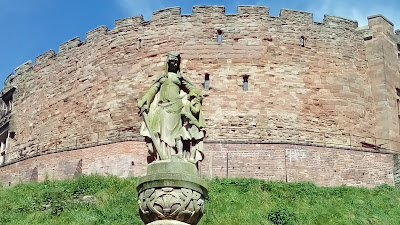Æthelstan, born in 895 AD, was the eldest son of Edward the Elder and grandson of Alfred the Great. He spent his childhood in the care of his aunt, Æthelflæd, the Lady of the Mercians. He was crowned as King of the Anglo-Saxons at Kingston-upon-Thames on 4th September, 925. Much of his reign was occupied, as were his forefather's, with the ongoing struggle against invading Vikings.
 |
| Æthelflæd with the boy Æthelstan, Tamworth Castle. |
Within six years the Great Heathen Army was about to overrun Wessex, the last Anglo-Saxon kingdom standing. King Alfred famously repelled the storm at the Battle of Edington in 878 when his Anglo-Saxon army of Wessex defeated the Heathens led by Guthrum.
Guthrum accepted baptism and returned to the east of the country where he ruled over the territories of East Anglia, Essex and Eastern Mercia. In time these lands would became known as the Danelaw. In 886 Alfred and Guthrum formalised a treaty defining the boundaries of their respective kingdoms, making provision for peaceful relations between the Anglo-Saxons and Vikings.
By the time of Æthelstan's reign, Edward the Elder and his sister Æthelflæd had recovered much of the Danish occupied territories in the Midlands and East Anglia in a series of campaigns in the 910s continuing their father’s policy of building a string of fortresses, known as burhs.
However, when Æthelstan came to the throne in 925 much of the north of England was still under Danish control. Two years later in 927, Æthelstan ejected the Viking leader Gofraid ua Ímair from York and brought Northumbria under English control. He then marched north when on 12th July 927 the Anglo Saxon Chronicle records that he exerted lordship over northern Britain at Eamont, near Penrith in Cumbria, when Ealdred of Bamburgh, Owain of Strathclyde, Constantine of Scotland and Hywel Dda of Deheubarth all accepted Æthelstan as the first English king to achieve lordship over northern Britain.
Following the meeting at Eamont Æthelstan summoned the five Welsh kings to Hereford where he imposed a heavy annual tribute and fixed the Anglo-Welsh border at the River Wye. He then turned to Exeter where he brought the Celts of Cornwall under his dominion.
The Battle of Brunanburh
In 937 Æthelstan led a combined Anglo-Saxon army from Mercia and Wessex with his brother Edmund in one of the bloodiest battles ever fought on British soil in which five kings and seven earls lost their lives. The battle was Æthelstan's greatest achievement and a defining moment in British history, bringing the Anglo-Saxon kingdoms into a unified England.
The Battle of Brunanburh saw Æthelstan's forces defeat the allied forces of Olaf III Guthfrithson (Gofraid of York's son), the Norse-Gael King of Dublin; Constantine II, King of Scots; and Owen I, King of Strathclyde. But despite its fame, the site of the battle remains a mystery.
Compelling arguments have been made for locations in Yorkshire, Northamptonshire, Lancashire and Scotland by historians. However, Bromborough on Wirral is thought to be one of the most likely candidates. The name ' Bromborough' was used until the early 18th century and said to be derived from the Old English 'Brun's fort' (Brunan-burh).
 |
| Wirral |
The defeated Viking army escaped through Thingwall wood then to Heswall Slack (slakki), and then to the Heswall shore at Sheldrakes, believed to be the site of the 'Thing’s mere', or Dingesmere, from where the Norsemen fled. The Irish Chronicles record the first peaceful settlements on Wirral by the Norseman Ingimund in 902. Yet, no sooner than the peninsula became full of Norse settlers repeated raids on Chester are reported.
The battle is referred to 'the greatest single battle in Anglo-Saxon history before the Battle of Hastings' as Athelstan's devastating defeat of the combined Norse-Celtic force confirmed England as an Anglo-Saxon kingdom forcing the Celtic kingdoms to consolidate in the lands they have occupied to the present day.
The Empty Tomb
Æthelstan died at Gloucester on 27 October 939. No sooner had he died than the Vikings took back control of York until 954 when it was finally reconquered with Eric Bloodaxe being expelled by King Eadred, another son of Edward the Elder, and the region returned to full English control once more.
His grandfather Alfred and his father Edward had been interred at Winchester, but Æthelstan requested to be buried at Malmesbury Abbey alongside his cousins who died at Brunanburh. No other member of the West Saxon royal family was buried there.
 |
| Malmesbury Abbey |
William of Malmesbury, who claimed to have seen the King's remains in the early 12th century, described him as being "of middle height, thin in person, his hair flaxen as I have seen by his relics, and beautifully wreathed with golden threads".
Æthelstan's relics were lost at the time of the dissolution of the abbey in 1539. They may have been destroyed or scattered by King Henry VIII's commissioners, or possibly secretly hidden by the faithful beforehand.
* * *

No comments:
Post a Comment
Note: only a member of this blog may post a comment.